Wisdom Tooth Removal in Owasso, OK
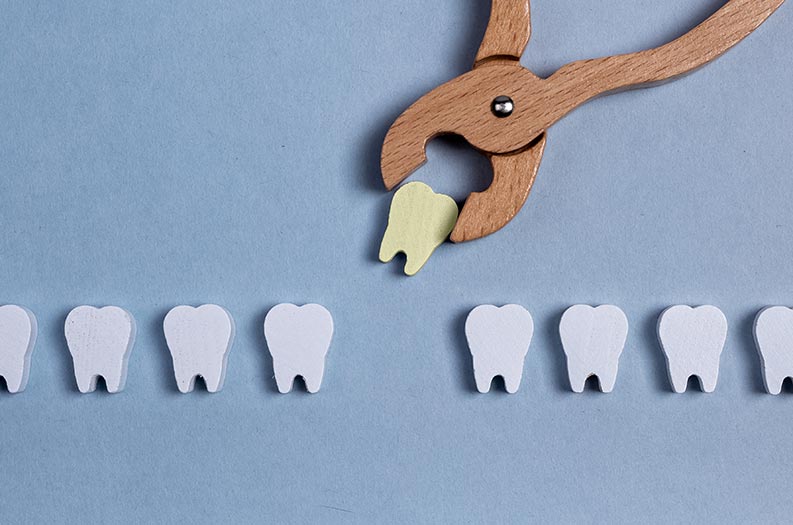
Gentle Third Molar Extraction at a Dentist’s Office Near You
How do you know when wisdom teeth need to be removed? The answer depends on several factors, including available space in your mouth, the angle of eruption, and whether they’re causing pain or other complications. As Owasso’s trusted family dentist, we combine advanced surgical techniques with the compassionate family dental care that helps you feel confident and supported throughout your entire experience.
Experiencing wisdom tooth pain or have questions about removal? Call Lexington Dental of Owasso at (918) 274-8500 to schedule your consultation today. We provide expert, gentle wisdom teeth removal for patients from Claremore, Tulsa, Collinsville, and throughout the greater Oklahoma area, always with your comfort as our top priority.
Dr. Cary's Philosophy: Family Dental Care with Genuine Compassion
Dr. Jacob Cary brings both advanced surgical training and genuine empathy to wisdom teeth removal. Having completed his dental education at New York University and returned to serve his Oklahoma community, he understands that this procedure often represents a young person’s first significant dental experience.
His approach goes beyond technical skill to include patient education, emotional support, and careful attention to each individual’s comfort level and concerns. Dr. Cary believes that a positive experience with wisdom teeth removal can set the foundation for a lifetime of confident dental care.
What sets our practice apart is our commitment to making every patient feel like a valued member of our dental family. Whether you’re a nervous teenager or a busy parent finally addressing long-postponed wisdom teeth issues, you’ll receive the same gentle, patient-centered care that has made us Owasso’s trusted family dentist.
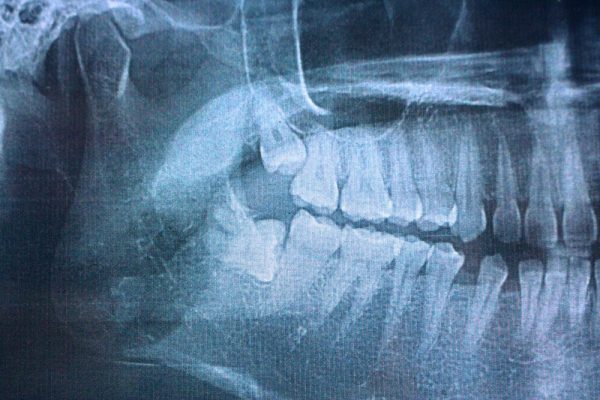
What Are Wisdom Teeth?
Wisdom teeth, also known as third molars, are the final set of permanent teeth to develop and emerge in the mouth, typically appearing between the ages of 17 and 25. These teeth are evolutionary remnants from our ancestors, who required additional molars to process their coarse, primitive diet.
In modern humans, jaw sizes have decreased over time while tooth sizes have remained relatively constant, creating insufficient space for wisdom teeth to emerge properly in most people. This size discrepancy often leads to impaction, crowding, pain, and other complications that necessitate professional removal. While some individuals have adequate space for their wisdom teeth and experience no problems, the majority of people benefit from having these third molars removed to prevent future oral health issues.
Types of Wisdom Tooth Impaction
Understanding different types of impaction helps patients recognize their situation and treatment needs:
Common Impaction Categories
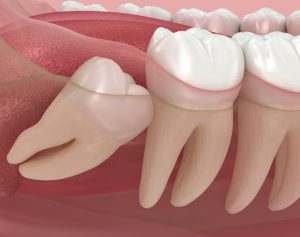 Soft Tissue Impaction: The tooth has enough space to emerge but remains partially covered by gum tissue, creating pockets where bacteria and food particles accumulate, leading to infection and gum disease.
Soft Tissue Impaction: The tooth has enough space to emerge but remains partially covered by gum tissue, creating pockets where bacteria and food particles accumulate, leading to infection and gum disease.- Partial Bony Impaction: The wisdom tooth is partially blocked by bone, preventing complete eruption and often causing the tooth to emerge at an angle that creates cleaning difficulties and potential damage to adjacent teeth.
- Complete Bony Impaction: The tooth remains completely encased in jawbone and cannot emerge naturally, often requiring more complex surgical procedures to access and remove safely.
Positioning Problems
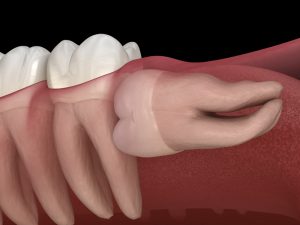 Horizontal Impaction: The tooth lies sideways beneath the gum line, often pressing against the roots of the second molar and potentially causing significant damage if not addressed promptly.
Horizontal Impaction: The tooth lies sideways beneath the gum line, often pressing against the roots of the second molar and potentially causing significant damage if not addressed promptly.- Vertical Impaction: The tooth is positioned correctly but lacks adequate space to fully emerge, often causing crowding and pressure against the second molar.
- Angled Impaction: The tooth is tilted forward or backward, creating challenges for both oral hygiene maintenance and surgical removal procedures.
Common Problems Caused by Wisdom Teeth
Wisdom teeth can create numerous oral health complications that affect both immediate comfort and long-term dental wellness:
- Infection and Gum Disease: The location of wisdom teeth makes them extremely difficult to clean properly, creating ideal conditions for bacterial growth. Pericoronitis, a painful infection of the gum tissue surrounding partially erupted wisdom teeth, causes swelling, pain, and difficulty opening the mouth.
- Damage to Adjacent Teeth: Wisdom teeth can cause substantial damage to healthy second molars positioned directly in front of them. The pressure from emerging or impacted wisdom teeth can push against these molars, causing them to shift position and become crowded.
- Oral Hygiene Challenges: Even when wisdom teeth emerge successfully, their location makes thorough cleaning nearly impossible for most patients, leading to plaque accumulation, tooth decay, and gum disease.
- Cyst Formation: Impacted wisdom teeth can develop fluid-filled cysts around the tooth crown, which gradually enlarge and destroy surrounding jawbone, teeth, and nerves.
Benefits of Wisdom Teeth Removal
Professional wisdom tooth extraction provides numerous advantages for oral health and overall well-being:
- Prevention of Crowding: Removing wisdom teeth prevents them from pushing against other teeth and causing misalignment, protecting previous orthodontic work, and maintaining proper tooth positioning.
- Elimination of Pain: Extraction relieves the chronic pain, pressure, and discomfort associated with impacted or problematic wisdom teeth, allowing patients to eat, speak, and sleep comfortably.
- Infection Prevention: Removing teeth that cannot be properly cleaned eliminates the source of recurring infections, reducing the risk of serious complications and improving overall oral health.
- Protection of Adjacent Teeth: Early removal prevents damage to healthy second molars, avoiding the need for future restorative treatments like fillings, crowns, or root canals.
- Improved Oral Hygiene: Eliminating hard-to-reach wisdom teeth makes daily oral care more effective, reducing the overall risk of cavities and gum disease throughout the mouth.
- Orthodontic Stability: For patients who have had braces, wisdom tooth removal helps maintain the results of orthodontic treatment by preventing late-stage crowding.
- Preventive Cost Savings: Early extraction is typically less expensive and complex than waiting until problems develop, avoiding emergency procedures and extensive treatments.
Who Should Consider Wisdom Teeth Removal?
- Patients with Impacted Teeth: Individuals whose wisdom teeth cannot emerge properly due to insufficient space, abnormal positioning, or obstruction by bone or other teeth.
- Those Experiencing Pain or Discomfort: People suffering from chronic pain, pressure, swelling, or jaw stiffness related to wisdom tooth eruption or impaction.
- Patients with Recurring Infections: Individuals who experience repeated episodes of pericoronitis or other infections around wisdom teeth that compromise oral health.
- Orthodontic Patients: People who have completed braces treatment and want to protect their investment by preventing wisdom tooth-related crowding.
- Young Adults: Patients in their late teens or early twenties, when wisdom tooth roots are not fully formed, making extraction easier and recovery faster.
- Patients with Oral Hygiene Challenges: Individuals who struggle to clean wisdom teeth effectively due to their location, gag reflex, or physical limitations.
The Wisdom Teeth Removal Process at Lexington Dental of Owasso
Initial Consultation and Planning
- Comprehensive Examination: Dr. Cary performs a thorough evaluation of your wisdom teeth, including assessment of their position, development stage, and impact on surrounding structures.
- Advanced Imaging: Panoramic X-rays or 3D imaging provide detailed views of tooth positioning, root development, and proximity to important structures like nerves and sinuses.
- Treatment Planning: Based on examination findings, Dr. Cary develops a personalized extraction plan, discussing the complexity of your case, anesthesia options, and expected recovery timeline.
- Pre-Surgical Instructions: Detailed preparation guidelines help optimize healing and minimize complications, including dietary restrictions and medication protocols.
Extraction Procedure
- Anesthesia Administration: Appropriate anesthesia is provided for your comfort, ranging from local numbing to conscious sedation based on procedure complexity and patient preference.
- Surgical Access: For impacted teeth, your dentist or oral and maxillofacial surgeon creates precise incisions in the gum tissue and may remove small amounts of bone to access the tooth safely.
- Tooth Removal: The tooth is removed using controlled techniques that preserve surrounding bone and soft tissues while avoiding damage to adjacent teeth or nerves.
- Site Care: The extraction sites are thoroughly cleaned and sutured if necessary to promote optimal healing and minimize bleeding.
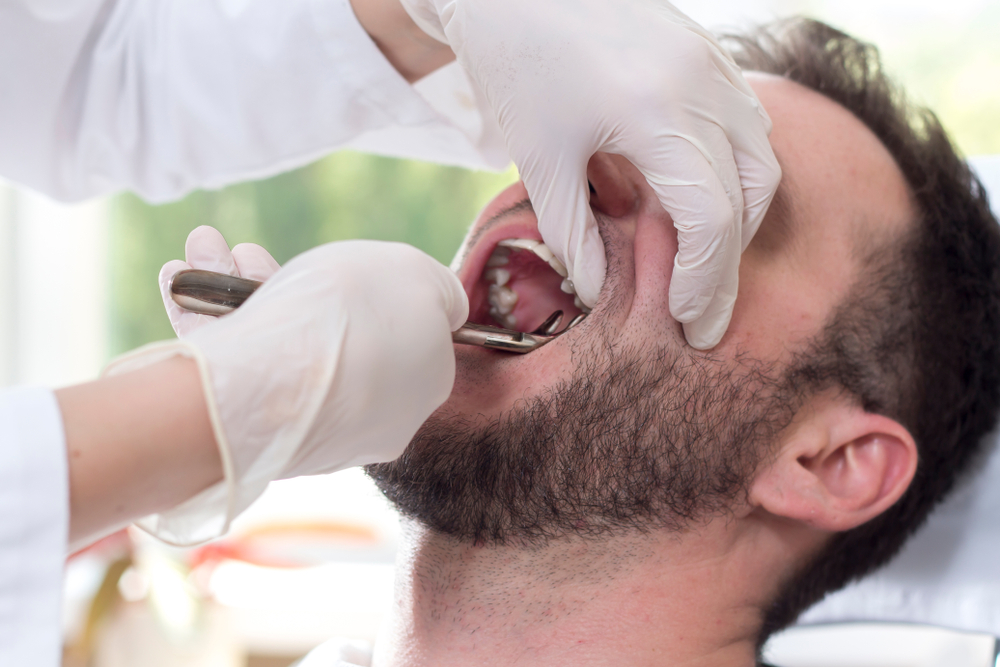
Recovery and Post-Operative Care
Proper care after having wisdom teeth removed is essential for comfortable healing and complication prevention:
Immediate Recovery (First 24-48 Hours): Rest with your head elevated, apply ice packs intermittently to reduce swelling, and follow medication schedules carefully. Gentle activities are acceptable, but strenuous exercise should be avoided to prevent bleeding.
Pain and Swelling Management: Take prescribed medications as directed, apply ice packs for 15-20 minutes several times daily during the first 48 hours, and keep your head elevated while sleeping to reduce swelling.
Dietary Guidelines: Stick to soft, cool foods for the first few days, including yogurt, smoothies, soup, and mashed potatoes. Gradually reintroduce normal foods as comfort allows, but avoid hard, crunchy, or sticky foods.
Oral Hygiene: Avoid brushing near the extraction sites for the first day, then gently clean your teeth while avoiding the surgical areas. After 24 hours, gentle saltwater rinses can help keep the extraction sites clean and promote healing.
Most patients can return to work or school within three to five days, with complete healing occurring over one to two weeks. Dr. Cary provides detailed aftercare instructions and monitors healing progress through follow-up appointments.
Frequently Asked Questions
The optimal age for wisdom tooth removal is typically between 16 and 25, when the roots are not fully developed and the bone is less dense, making extraction easier and recovery faster. However, problematic wisdom teeth should be removed at any age to prevent complications. Dr. Cary evaluates each case individually, considering factors like tooth development, available space, and symptoms to determine the best timing. Delaying removal when problems exist can lead to more complex procedures and longer recovery times.
Simple wisdom tooth extractions typically take 15-30 minutes per tooth, while surgical removal of impacted teeth may require 30-60 minutes per tooth, depending on complexity. Multiple teeth can often be removed in a single appointment, with total procedure time ranging from 30 minutes to two hours based on the number and difficulty of extractions. Dr. Cary provides time estimates during your consultation based on your specific case and imaging findings.
Local anesthesia is standard for all wisdom tooth extractions, completely numbing the surgical area while you remain conscious and comfortable. For multiple extractions or anxious patients, conscious sedation options like nitrous oxide or oral sedation provide additional relaxation while maintaining safety. Dr. Cary discusses anesthesia options based on your procedure complexity, medical history, and comfort preferences.
Some facial swelling is normal after wisdom tooth extraction, typically peaking two to three days after surgery before gradually subsiding. The amount of swelling varies based on extraction complexity and individual healing response. Ice packs during the first 48 hours help minimize swelling, while warm compresses after this period can promote healing. Most swelling resolves within a week, though some minor puffiness may persist slightly longer for complex surgical cases.
If you receive only local anesthesia, you can typically drive yourself home after the procedure once you feel alert and comfortable. However, if you receive any form of sedation, including nitrous oxide or oral sedatives, you’ll need someone to drive you home and should avoid operating vehicles for the remainder of the day. Dr. Cary provides specific guidelines based on your anesthesia type and individual response.
Our Family Dentist Near You Provides Wisdom Tooth Extraction for All Ages
Don’t let problematic wisdom teeth compromise your oral health or quality of life. Early evaluation and treatment can prevent serious complications while providing the most comfortable treatment experience. At Lexington Dental of Owasso, Dr. Jacob Cary provides thorough evaluations and gentle wisdom tooth removal services using advanced techniques and personalized care approaches.
Ready to address your wisdom tooth concerns? Call Lexington Dental of Owasso at (918) 274-8500 to schedule your consultation today. Located at 8500 N 129th East Avenue in Owasso, we provide expert wisdom teeth removal for patients from Claremore, Tulsa, Collinsville, and throughout the greater Oklahoma area. Take control of your oral health with Owasso’s professional wisdom tooth treatment.

